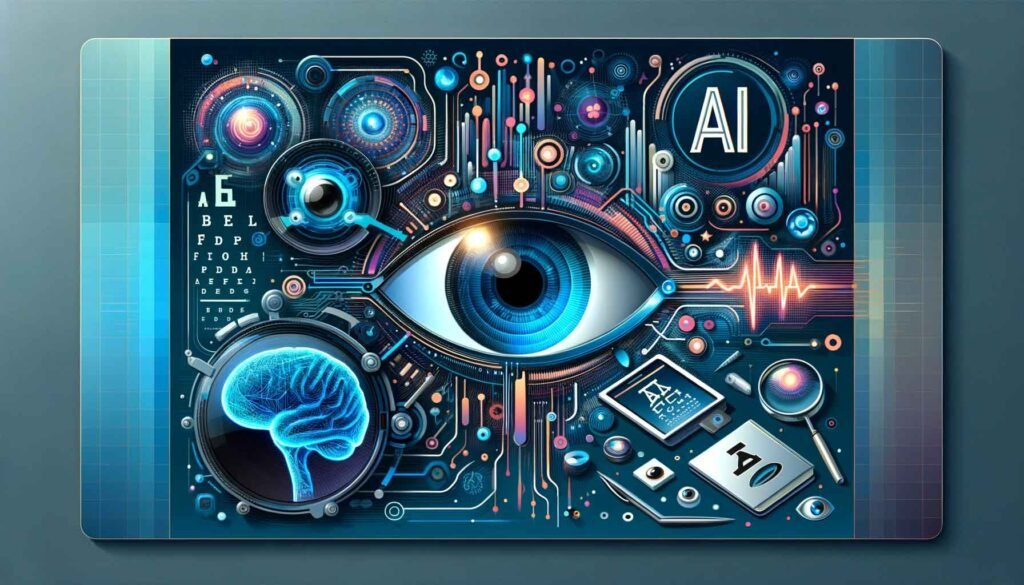
Summary: From delivering expert-level diagnoses in the most remote corners of the world to revolutionizing treatment plans, AI is redefining what’s possible in the realm of eye health. Whether it’s battling against the prevalence of eye diseases with unparalleled precision or democratizing healthcare in low- and middle-income countries, AI is at the forefront of a healthcare revolution.
But it’s not all smooth sailing. The blog also uncovers the challenges lurking behind these advancements: regulatory hurdles, ethical dilemmas, and the pressing need for global acceptance and trust in AI. This is a must-read for anyone intrigued by the intersection of technology and healthcare, offering a glimpse into a future where AI and human expertise converge to create a visionary era in eyecare. Get ready to be captivated by the potential, challenges, and transformative power of AI in the world of vision care!
Index
- Introduction
- Potential of AI in Eyecare
- AI in Low- and Middle-Income Countries
- Challenges in AI Integration
- Conclusion
Introduction
The landscape of eyecare is undergoing a significant transformation, thanks to the advancements in Artificial Intelligence (AI). With an increasing prevalence of eye diseases globally, AI offers innovative solutions for early diagnosis and effective management. This blog provides an insightful look into how AI is not just an auxiliary tool but a fundamental shift in the approach to eye health.
Read Also : The Future of Healthcare: AI’s Revolutionary Role in 2024
Potential of AI in Eyecare
AI’s potential in eyecare is vast and multifaceted. Technologies such as deep learning algorithms have shown exceptional ability in analyzing complex medical images, leading to more accurate diagnoses of conditions like diabetic retinopathy, macular degeneration, and glaucoma. These AI-driven systems can identify subtle patterns in data that might be overlooked by human experts, thus enhancing the precision of diagnoses and enabling early intervention.
The use of AI in eyecare extends beyond diagnosis. It plays a crucial role in predicting disease progression, personalizing treatment plans, and even assisting in surgical procedures. AI algorithms are being developed to analyze patient data and predict individual risk factors, leading to more targeted and effective treatments.
AI in Low- and Middle-Income Countries (LMICs)
In low- and middle-income countries (LMICs), where access to healthcare professionals and resources is often limited, AI can be a game-changer. AI-driven diagnostic tools can be deployed in remote areas, bringing expert-level screening and diagnosis to populations that previously had little to no access to such services. This democratization of healthcare through AI can lead to significant improvements in early detection and treatment of eye diseases in these regions.
However, the implementation of AI in LMICs faces its own set of challenges, including limited infrastructure, lack of training, and resource constraints. Efforts to introduce AI in these settings must be accompanied by strategies to address these challenges, ensuring that the benefits of AI in eyecare are accessible to all.
Read Also : Now, AI Can Be Your Doctor, Thanks to Google?
Challenges in AI Integration
Integrating AI into global eyecare systems is not without challenges. One of the primary concerns is the regulatory landscape, which is still evolving to keep pace with rapid technological advancements. Ensuring patient privacy and data security is another critical aspect, especially as AI systems often require large datasets for training and validation.
Additionally, there is the issue of trust and acceptance among healthcare professionals and patients. For AI to be effectively integrated into clinical practice, both practitioners and patients need to understand and trust the technology. This requires extensive training, education, and transparent communication about how AI works and its benefits.
Conclusion
AI holds enormous potential to transform eyecare globally. It can lead to more accurate diagnoses, personalized treatments, and improved access to care, especially in underserved regions. However, realizing this potential requires overcoming significant challenges, from regulatory issues to infrastructural limitations. As the field of AI in eyecare continues to evolve, it offers a promising future where technology and human expertise work hand in hand to improve eye health worldwide.
Here are some online sources that provide valuable information about the role of AI in eyecare:
- National Center for Biotechnology Information (NCBI)
- Title: Studies of AI Systems in Eye Care
- URL: ncbi.nlm.nih.gov/pmc/articles/PMC9732481
- American Academy of Ophthalmology
- Title: Artificial Intelligence Trends in Eye Care
- URL: aao.org/eye-health/news/artificial-intelligence-trends
- Stanford Medicine
- Title: Improving Ophthalmologic Care Through Artificial Intelligence
- URL: med.stanford.edu/news/all-news/2020/05/improving-ophthalmologic-care-through-artificial-intelligence.html
- HealthTech Magazine
- Title: Innovations in Eye Care: How Tech Is Changing Ophthalmology
- URL: healthtechmagazine.net/article/2020/03/innovations-eye-care-how-tech-changing-ophthalmology
- American Academy of Ophthalmology
- Title: Artificial Intelligence in the Clinic: Eye Care’s Pioneering Use of Big Data
- URL: aao.org/eyenet/article/ai-in-clinic-eye-care-s-pioneering-use-of-big-data
- Optometry Times
- Title: How Artificial Intelligence Is Changing the Future of Optometry
- URL: optometrytimes.com/view/how-artificial-intelligence-changing-future-optometry
- Optometric Management
- Title: Recent Availability of AI in Eye Care
- URL: optometricmanagement.com/issues/2020/march-2020/recent-availability-of-ai-in-eye-care
These sources provide a comprehensive look at how AI is being used in eyecare, its advancements, and the impact it has on the field. They offer a mix of academic research, professional insights, and industry trends.


